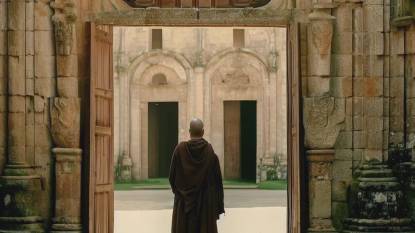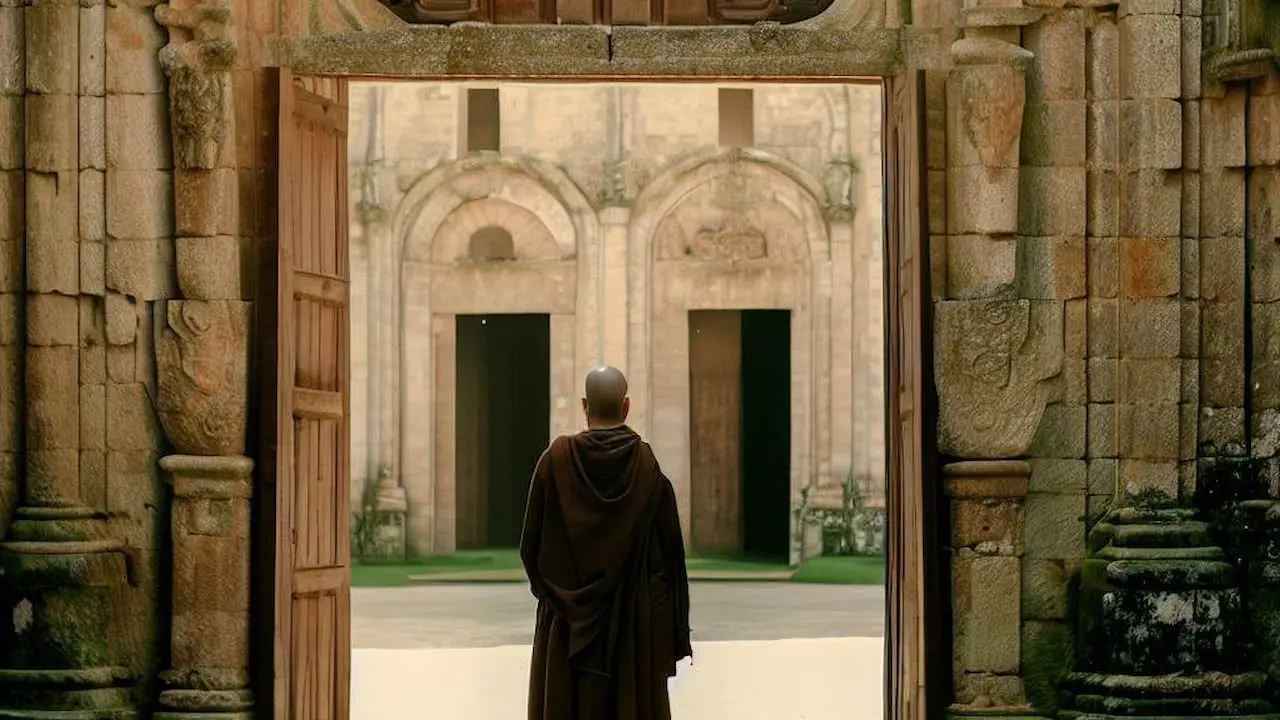
Exploring the Monastery of Santa María in Sobrado dos Monxes
Posted: | Updated:
Reading time: 29 minutes
Exploring the Monastery of Santa María in Sobrado dos Monxes
Posted: | Updated:
Reading time: 29 minutes
By: Simon Kemp, Editor
The Monastery of Santa María in Sobrado dos Monxes is a captivating sight located in the Galicia region of Spain. As one of the significant cultural gems along the Camino Inglés pilgrimage , I thought it prudent to take a deeper look at this historical & religious masterpiece. So here is our comprehensive guide to “Sobrado Abbey”. As I explain below, the Monastery has many names!
Founded in the 10th century by Cistercian monks, the monastery’s historical origins can be traced back to a humble religious community that grew over the centuries into a grand architectural treasure.
The monastery’s architecture is a remarkable fusion of Romanesque, Gothic, Renaissance, and Baroque styles. From the sturdy simplicity of its Romanesque foundation to the elegant grace of its Gothic arches and the opulence of its Baroque decorations, the monastery’s architectural evolution offers visitors a captivating journey through time.
Beyond its architectural grandeur, the Monastery of Santa María holds profound spiritual significance. Throughout history, it served as a center of prayer, study, and communal life for the monks and local residents. As a renowned pilgrimage site along the Camino Inglés, the English Way of the Camino de Santoago, the monastery attracted pilgrims from all over Europe, seeking spiritual solace and blessings.
Second only to the impressive Tower of Hercules , this Monastery is one of the oldest archetectural marvels that you will find along the Camino Inglés. Let’s dive into it’s rich history, it’s function as an Albergue and all the information you will ever need about the “Abbey of Sobrado”.
Key Takeaways
- Historical Origins: The monastery was established in the 10th century by Cistercian monks and underwent various expansions and reconstructions over the centuries. It played a significant role in the religious, social, and cultural life of the region.
- Architectural Marvels: The monastery’s architectural evolution encompasses Romanesque, Gothic, Renaissance, and Baroque styles, creating a captivating mosaic of artistic brilliance.
- Spiritual Significance: As a center of prayer, study, and pilgrimage, the monastery holds deep spiritual significance. It has attracted seekers and pilgrims for centuries, contributing to the region’s spiritual heritage.
- Cultural Influence and Preservation: The monastery’s library and archives have preserved Galician language, customs, and historical records. Its architectural legacy has influenced Galician art and architecture over time.
- Legends and Folklore: Captivating legends and folklore surround the monastery, adding an enchanting allure to its history and inspiring local art and literature.
- Ongoing Conservation Efforts: Dedicated conservation projects, public-private partnerships, and community involvement have ensured the preservation of the monastery for future generations.
- Visitor Experience and Tourism: The monastery offers guided tours, exhibitions, and cultural events, providing a captivating and immersive experience for travelers exploring its historical wonders.
- Entrance Fees: As of the last update in September 2021, the monastery did not charge an entrance fee for visitors to explore the main areas.
- Visitor Facilities: The monastery provides facilities such as an information center, guided tours, restrooms, a gift shop, and accessibility measures.
- FAQs: Frequently asked questions address common queries about the monastery, including its UNESCO World Heritage status, legends, visitor facilities, and conservation efforts.
Map of Sobrado Abbey
Other names for the Monastery of Santa María in Sobrado dos Monxes
The Monastery of Santa María in Sobrado dos Monxes is known by several other names, reflecting its rich history. Some of the alternative names for the monastery include:
- Sobrado Abbey: The term “abbey” is commonly used to refer to a monastery or convent, especially one headed by an abbot or an abbess. Sobrado Abbey denotes the religious and administrative importance of the monastery within the Cistercian order.
- Sobrado Monastery: This simple and direct name highlights the primary function of the site as a place of monastic life, devotion, and religious practice.
- Mosteiro de Santa María de Sobrado dos Monxes: the Galician name for the monastery, differing from the Spanish somewhat which is listed below.
- Monasterio de Santa María de Sobrado de los Monjes: This is the Spanish translation of the monastery’s name. It emphasizes the dedication of the site to the Virgin Mary, symbolizing its spiritual significance.
- Santa María Monastery: This abbreviated name underscores the central devotion to the Virgin Mary, who is often revered as a significant figure in the monastic community.
- Convento de Santa María: In some contexts, the term “convento” is used interchangeably with “monasterio” in Spanish, referring to a religious institution where monks or nuns reside.
- Cistercian Monastery of Sobrado: The monastery was originally founded by Cistercian monks, and this name specifically highlights its historical affiliation with the Cistercian order.
- Sobrado dos Monxes Monastery: The name “Sobrado dos Monxes” is derived from the Galician language, and this alternate name emphasizes the location of the monastery in the town of Sobrado dos Monxes.
It is not uncommon for historical sites, especially ones with long and storied histories, to be known by multiple names in different languages or periods. Each name encapsulates a unique aspect of the monastery’s identity and its connection to the region’s religious and cultural heritage. Regardless of the name used, the Monastery of Santa María in Sobrado dos Monxes remains a timeless symbol of spirituality and architectural brilliance.
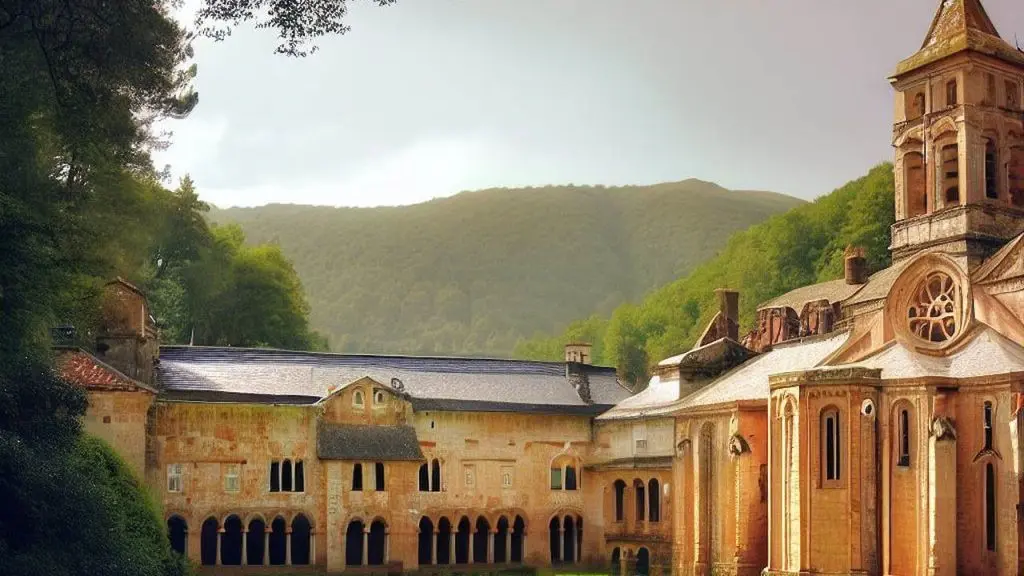
The Origins of Sobrado Abbey
The Monastery of Santa María in Sobrado dos Monxes, has a captivating history dating back to the 10th century. In this era, a group of devoted Cistercian monks laid the foundation for a modest religious community in the Galicia region of Spain. Over the following centuries, the monastery experienced a series of expansions and reconstructions, evolving into the grand architectural masterpiece we see today.
During the 10th century, the monastery began as a small religious community. However, it gradually expanded its premises to accommodate a growing number of monks and visitors. Notable architectural additions took place in the Gothic, Renaissance, and Baroque periods, creating a unique blend of styles that characterize the Monastery of Santa María.
The historical origins of the monastery are deeply intertwined with the religious and cultural fabric of the region. Throughout history, it played a significant role in shaping the spiritual life of the local community. The monastery served as a center of prayer, contemplation, and communal activities for the monks and the people living nearby.
The Monastery of Santa María became a renowned pilgrimage site, attracting devotees from various parts of Spain and beyond. Its fame as a place of spiritual retreat and solace drew visitors seeking divine guidance and tranquility.
The monastery’s architectural evolution is evident in its diverse structural features. For instance, the original Romanesque structure provides a strong foundation for the later embellishments. Visitors can witness the graceful arches and delicate stone carvings typical of the Gothic period, as well as the opulence and grandeur of the Baroque elements.
The historical significance of the Monastery of Santa María extends beyond its religious importance. It played a central role in preserving the cultural heritage of the Galician people. The monastery’s extensive library housed valuable historical documents, ancient literary works, and religious manuscripts. These archives are a testament to the region’s socio-economic life, agricultural practices, and local customs during different historical periods.
One notable historical figure associated with the monastery is Abbot Geraldo, who led significant reconstruction efforts during the 12th century. His vision and influence left a lasting impact on the monastery’s development.
In recent times, the Monastery of Santa María in Sobrado dos Monxes has attracted attention as an important part of the Camino Inglés UNESCO World Heritage Site. This designation highlights its importance as a significant cultural and historical landmark, deserving of preservation and protection for future generations to cherish and learn from. Efforts from dedicated conservators, historians, and local communities ensure that the rich history and architectural splendor of the monastery endure the test of time.
Who are the Cistercian Monks?
The Cistercian order of monks, also known as the Order of Cistercians or simply Cistercians, originated in the early 12th century as a reform movement within the Benedictine monastic tradition. The order was founded in 1098 by a group of monks led by Saint Robert of Molesme (Saint Robert), who sought to return to a stricter and more austere interpretation of the Rule of Saint Benedict.
At the time of its founding, many Benedictine monasteries had become wealthy and had relaxed some of the rigorous practices and asceticism originally outlined by Saint Benedict in the 6th century. Seeking a return to a simpler and more disciplined monastic life, Saint Robert, along with Stephen Harding and Alberic of Cîteaux, established a new monastery in Cîteaux, located in present-day Burgundy, France.
The name “Cistercian” comes from “Cistercium,” the Latin name for Cîteaux. The Cistercians adhered strictly to the Rule of Saint Benedict, focusing on manual labor, self-sufficiency, and prayer, while avoiding unnecessary luxury and extravagance. They also emphasized seclusion and silence, seeking solitude as a means to deepen their spiritual lives.
The Cistercians’ commitment to simplicity and austerity quickly gained popularity, attracting many new members and leading to the establishment of numerous daughter houses or “daughter monasteries.” These new monastic communities followed the principles of the mother house in Cîteaux, creating a network of Cistercian monasteries across Europe.
Under the leadership of Saint Bernard of Clairvaux, who joined the Cistercians in 1112, the order experienced significant growth and influence. Saint Bernard’s writings and teachings on mysticism, prayer, and theology resonated widely, drawing many followers to the Cistercian way of life. He played a crucial role in promoting the order and establishing Cistercian monasteries in various regions.
The Cistercians’ impact extended far beyond their monastic walls. Their emphasis on agricultural development, innovative farming practices, and the establishment of granges (agricultural estates) helped improve local economies and contributed to the development of medieval agriculture.
By the 12th and 13th centuries, the Cistercian order had become one of the most significant monastic orders in Europe. Their commitment to spiritual purity, intellectual pursuits, and manual labor earned them respect and admiration from both religious and secular authorities.
Today, the Cistercian order continues to exist and thrive, with monasteries around the world. The enduring legacy of the Cistercians lies in their commitment to simplicity, devotion to prayer, and the pursuit of God through a life of contemplation and labor.
Architectural Marvels
The Monastery stands as a captivating testament to architectural brilliance, featuring a harmonious blend of styles from various historical periods. From its humble beginnings as a Romanesque structure, the monastery underwent remarkable transformations over the centuries, incorporating elements of Gothic, Renaissance, and Baroque architecture.
The original Romanesque architecture, dating back to the 10th century, provides a solid foundation for the subsequent expansions. Characterized by sturdy walls, rounded arches, and simple ornamentation, this early structure reflects the architectural norms of its time.
During the Gothic period, in the 13th and 14th centuries, the monastery underwent significant enhancements. Graceful pointed arches, ribbed vaults, and flying buttresses adorned the interior and exterior, lending an air of elegance and verticality. The exquisite stone carvings depicting biblical scenes and religious figures stand as a testament to the skill and devotion of the medieval artisans.
The Renaissance period brought further architectural innovations to the Monastery of Santa María. Elaborate facades, adorned with classical motifs and sculptural elements, exude a sense of grandeur and sophistication. The cloister, a central feature of the monastery, showcases intricate arcades and delicate columns, reminiscent of the Renaissance style.
As the Baroque era unfolded in the 17th and 18th centuries, the monastery witnessed the addition of opulent chapels and altars, adorned with elaborate gilded decorations and intricate woodwork. The interior of the church dazzles visitors with its richness and splendor, epitomizing the exuberance of the Baroque period.
A notable architectural feature is the bell tower, added during the Gothic period. Rising majestically above the monastery’s grounds, the tower offers panoramic views of the surrounding countryside, a testament to the architects’ engineering prowess.
The Monastery of Santa María in Sobrado dos Monxes serves as a living testament to the architectural evolution of the region over several centuries. The seamless integration of different styles, from the simplicity of Romanesque to the grandeur of Baroque, creates a captivating and unique architectural mosaic. Today, visitors marvel at the intricate details, awe-inspiring vaulted ceilings, and breathtaking chapels, which stand as a tribute to the enduring craftsmanship and artistic vision of the past.
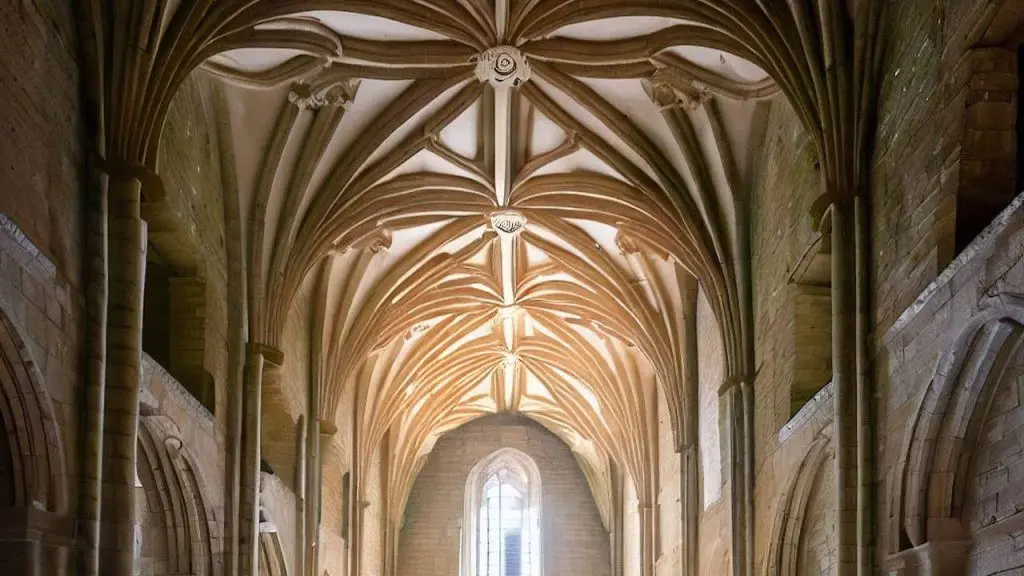
The Abbey’s Spiritual Significance
The Monastery holds profound spiritual significance, stemming from its establishment in the 10th century as a center of religious devotion and community life. Over the centuries, the monastery’s tranquil setting and sacred atmosphere have attracted pilgrims, seekers, and monks, fostering a deep connection with the divine.
During the medieval period, the monastery became renowned as a place of pilgrimage. In the 12th century, it became an important stop along the Camino de Santiago, a famous pilgrimage route in northern Spain. Pilgrims from all over Europe journeyed to the monastery, seeking spiritual solace and blessings on their arduous pilgrimage to the shrine of Saint James in Santiago de Compostela.
The Monastery of Santa María played a vital role in the spiritual life of the Cistercian monks who resided there. It served as a center of prayer, study, and reflection, with a dedicated scriptorium where monks diligently copied and preserved religious manuscripts. The monastery’s extensive library housed valuable religious texts, theological treatises, and liturgical works, reflecting its status as an intellectual hub of the region.
In addition to its religious significance, the monastery was a focal point for community life. Local residents often sought refuge within its walls during times of conflict or adversity. The monastery’s doors were open to all, providing a sense of security and belonging to those in need.
Throughout history, the Monastery of Santa María was associated with miraculous events and revered relics. One such instance occurred in the 13th century when the monastery allegedly obtained a fragment of the True Cross, a revered Christian relic believed to be a part of the cross on which Jesus was crucified. The presence of such sacred relics added to the monastery’s allure and attracted countless believers.
The religious art and architecture within the monastery further contributed to its spiritual significance. Lavishly adorned altars, religious paintings, and statues of saints created an ambiance of veneration, inspiring visitors to deepen their faith and devotion.
Cultural Influence and Preservation
The Monastery has exerted a profound cultural influence on the Galician people throughout its long history. Beyond its spiritual significance, the monastery’s library and archives have played a crucial role in preserving the cultural heritage of the region. Its historical and artistic treasures continue to inspire contemporary Galician art, music, and literature.
The monastery’s extensive library, dating back to medieval times, housed a vast collection of religious texts, literary works, and historical documents. In the 12th and 13th centuries, the scriptorium within the monastery served as a hub for manuscript production, with monks diligently copying religious texts and illuminating them with intricate designs. These illuminated manuscripts, known as “codices,” provide valuable insights into medieval Galician culture, language, and religious practices.
The preservation of these ancient manuscripts has proven instrumental in understanding the region’s history and cultural identity. Historians and linguists have studied the manuscripts to decipher the evolution of the Galician language and the social dynamics of medieval Galician society.
Moreover, the Monastery of Santa María’s archives hold a wealth of information on medieval agricultural practices, trade, and economic life in the region. These historical records offer invaluable glimpses into the daily lives and customs of the local population during different epochs.
The architectural heritage of the monastery itself has also influenced Galician architecture over the centuries. Elements of the monastery’s distinctive Romanesque, Gothic, Renaissance, and Baroque styles can be found in various historical buildings and churches across the region. The intricate stone carvings, ribbed vaults, and pointed arches inspired subsequent generations of architects, leaving an indelible mark on Galician architectural aesthetics.
Preserving the Monastery of Santa María has been a matter of cultural importance. Concerted efforts were made by local authorities, conservationists, and historians to ensure the preservation and restoration of this architectural gem.
By implementing strict conservation measures, the unique architectural features of the monastery have been safeguarded from the effects of weathering and human impact. Public and private partnerships have provided essential funding for restoration projects, allowing visitors to experience the monastery’s historical splendor.
The cultural legacy of the Monastery of Santa María continues to resonate with the Galician people and beyond. Its historical archives and architectural grandeur serve as a source of pride and inspiration, fostering a sense of connection with the region’s rich past.
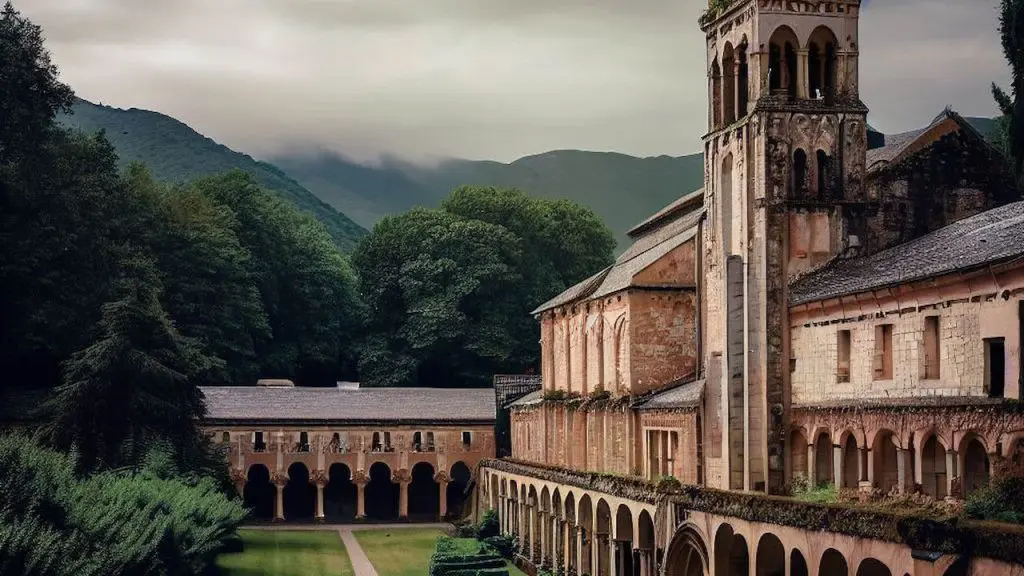
The Abbey’s Legends and Folklore
The Monastery is steeped in a tapestry of captivating legends and folklore, passed down through generations. These stories add an enchanting aura to the already mesmerizing site, drawing visitors and locals alike into a world of mystery and wonder.
One of the most enduring legends is that of the “White Lady.” According to local folklore, the ghostly apparition of a woman in white roams the halls of the monastery. The legend speaks of a tragic love story between a noblewoman and a young monk who resided at the monastery. Forbidden from being together, the couple’s love ended in heartbreak and despair. It is said that the White Lady’s spirit lingers in search of her lost love, creating an atmosphere of melancholy and romantic allure.
Another intriguing tale surrounds a hidden treasure said to be buried within the monastery’s grounds. According to the legend, during a time of war and turmoil, the monks concealed a cache of precious jewels and artifacts to protect them from invaders. The exact location of the treasure remains a mystery, inspiring treasure hunters and adventurers to search for the legendary hoard.
Additionally, the monastery has been linked to stories of miraculous events and divine intervention. One such tale recounts an occasion when a devastating fire threatened to consume the entire monastery. As the monks fervently prayed for salvation, the wind abruptly changed direction, guiding the flames away from the sacred site. This event came to be known as the “Miracle of Santa María,” reinforcing the monastery’s reputation as a place of spiritual grace.
Legends and folklore often intertwine with historical events and real-life figures associated with the monastery. The tales of ghostly encounters, hidden treasure, and miraculous events have been passed down through generations, becoming an integral part of the region’s cultural heritage.
These captivating stories have not only fueled the imagination of visitors but have also inspired local art, literature, and cultural expressions. Poets, writers, and artists have drawn inspiration from the monastery’s legends, infusing their works with the enchanting essence of these tales.
Ongoing Conservation Efforts
The preservation and safeguarding of the Monastery of Santa María in Sobrado dos Monxes have been the focus of dedicated and ongoing conservation efforts. The monastery holds immense cultural and historical value, making its protection a top priority.
In recent years, various conservation projects have been undertaken to ensure the structural integrity and longevity of the monastery. Renowned experts in architecture, archaeology, and historical preservation have collaborated to devise meticulous restoration plans, adhering to the principles of authenticity and minimal intervention.
One significant restoration effort took place in the early 2000s, when a comprehensive conservation project was initiated to address the aging and deteriorating elements of the monastery. This restoration project targeted the intricate stone carvings, the roof, and the cloister, among other architectural features. Skilled artisans and craftsmen meticulously worked to restore the delicate carvings, preserving their original beauty while stabilizing the structures for the future.
A key component of ongoing conservation efforts involves the implementation of preventive measures to protect the monastery from environmental factors and human impact. Climate monitoring systems have been installed to assess temperature, humidity, and other conditions that may affect the building’s stability. Additionally, conservationists regularly inspect the site for signs of deterioration or potential risks.
To fund these conservation endeavors, public and private partnerships have been formed. Local authorities, regional governments, and international organizations have allocated resources to support the preservation of the Monastery of Santa María. Additionally, private donations and sponsorships from businesses and individuals who recognize the site’s significance have contributed to the conservation efforts.
Community involvement has also been instrumental in the preservation of the monastery. Local residents and organizations have actively participated in restoration initiatives, demonstrating their commitment to protecting their cultural heritage. Educational programs and workshops have been organized to raise awareness among the younger generation about the importance of preserving historical landmarks.
Tourism management strategies have been carefully developed to strike a balance between visitor access and conservation needs. The implementation of guided tours and visitor guidelines helps mitigate potential impacts on the fragile historical structures and delicate artifacts within the monastery.
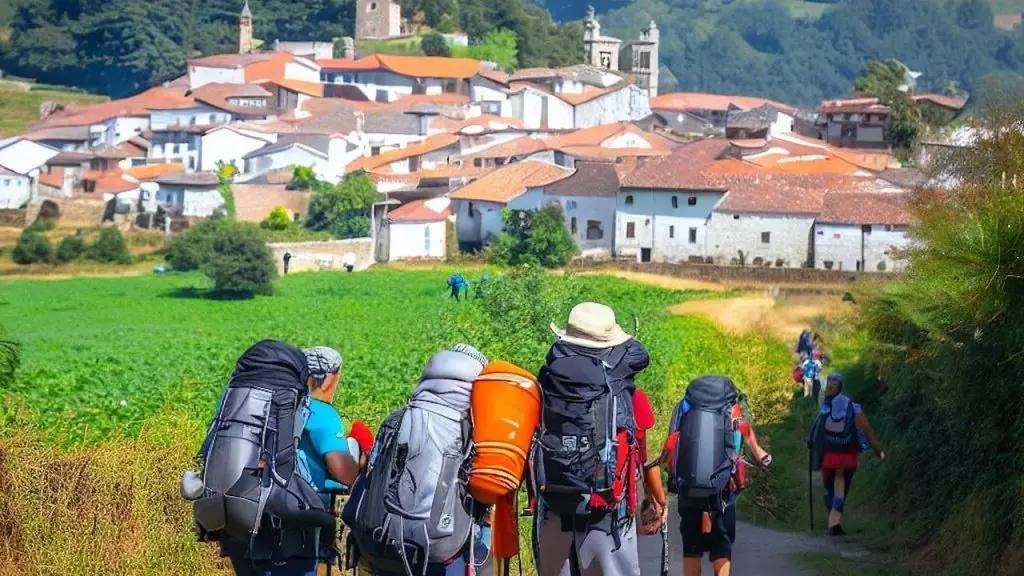
Sobrado Abbey Visitor Experience and Tourism
The Monastery of Santa María attracts a steady stream of domestic and international visitors each year, offering them a unique and enriching experience.
Visitors to the monastery are immersed in a journey through time, as they step into the hallowed halls that have witnessed centuries of devotion and cultural influence. Guided tours, led by knowledgeable experts, provide insightful narratives about the monastery’s history, architecture, and spiritual heritage. These tours allow visitors to delve deeper into the stories of the monks, the legends, and the remarkable architecture that define the site.
Throughout the year, the Monastery of Santa María hosts art exhibitions, showcasing local and international artists inspired by the site’s history and splendor. These exhibitions add a contemporary dimension to the visitor experience, bridging the gap between the past and the present through art.
Workshops and educational programs have been organized to engage visitors of all ages in hands-on activities related to the monastery’s cultural heritage. For example, visitors can partake in calligraphy workshops, where they learn the art of medieval writing using quills and ink, mirroring the practices of scribes who once resided within the monastery.
Moreover, the monastery often hosts concerts, featuring performances of ancient and traditional music, resonating with the spiritual essence of the site. These musical events provide a unique opportunity for visitors to experience the ambiance of the monastery through its sacred melodies.
The monastery’s serene surroundings and historical ambiance make it a sought-after destination for pilgrims seeking a spiritual retreat. Walking in the footsteps of countless pilgrims who journeyed to the site over the centuries, modern-day pilgrims can experience moments of tranquility and introspection within the monastery’s sacred walls.
The impact of tourism on the local community and economy cannot be overlooked. The influx of visitors has led to the development of tourism infrastructure in the surrounding area, including accommodations, restaurants, and cultural facilities. Local artisans and businesses have also benefitted from increased demand for traditional crafts and products related to the monastery’s cultural heritage.
To ensure the sustainability of tourism at the site, efforts have been made to strike a balance between visitor access and conservation needs. Visitor guidelines and management strategies have been implemented to protect the delicate architectural elements and historical artifacts within the monastery.
How to Get to The Monastery of Santa María in Sobrado dos Monxes
Traveling to the Monastery by public transportation is a convenient and accessible option for visitors. The site’s location in the Galicia region of Spain ensures that it is well-connected to nearby towns and cities through various public transportation options. Here are the different ways to reach the monastery from nearby areas:
1. From Santiago de Compostela:
- By Bus: Regular bus services operate between Santiago de Compostela and Sobrado dos Monxes. The journey takes approximately 1.5 to 2 hours, depending on the specific bus route and stops. Visitors can catch the bus at the Estación de Autobuses de Santiago (Santiago Bus Station).
2. From A Coruña:
- By Train and Bus: Visitors can take a train from A Coruña to the nearby city of Betanzos . From Betanzos, regular bus services are available to Sobrado dos Monxes, with a travel time of about 45 minutes to an hour.
3. From Lugo:
- By Bus: Lugo, another significant city in Galicia, is well-connected to Sobrado dos Monxes by bus. Regular services are available from Lugo’s Estación de Autobuses (Bus Station), and the journey typically takes around 1.5 to 2 hours.
4. From Betanzos:
- By Bus: For travelers starting their journey from Betanzos, direct buses to Sobrado dos Monxes are available, making the commute convenient and efficient. The travel time is usually around 45 minutes to an hour.
5. From other nearby towns and villages:
- Many smaller towns and villages in the region also have regular bus services connecting them to Sobrado dos Monxes. Travelers can inquire at local bus stations or check online for schedules and routes specific to their location.
It is essential to verify the latest schedules and routes, as public transportation timetables may vary depending on the season and other factors. Local tourist information centers or official transportation websites are reliable sources for up-to-date information.
Once visitors arrive in Sobrado dos Monxes, the Monastery of Santa María is usually within walking distance from the bus stop in the town center. The proximity of the monastery to the town makes it easily accessible for visitors relying on public transportation.
Traveling by public transportation not only offers convenience but also allows visitors to immerse themselves in the local culture and experience the picturesque Galician countryside as they journey to the awe-inspiring Monastery.
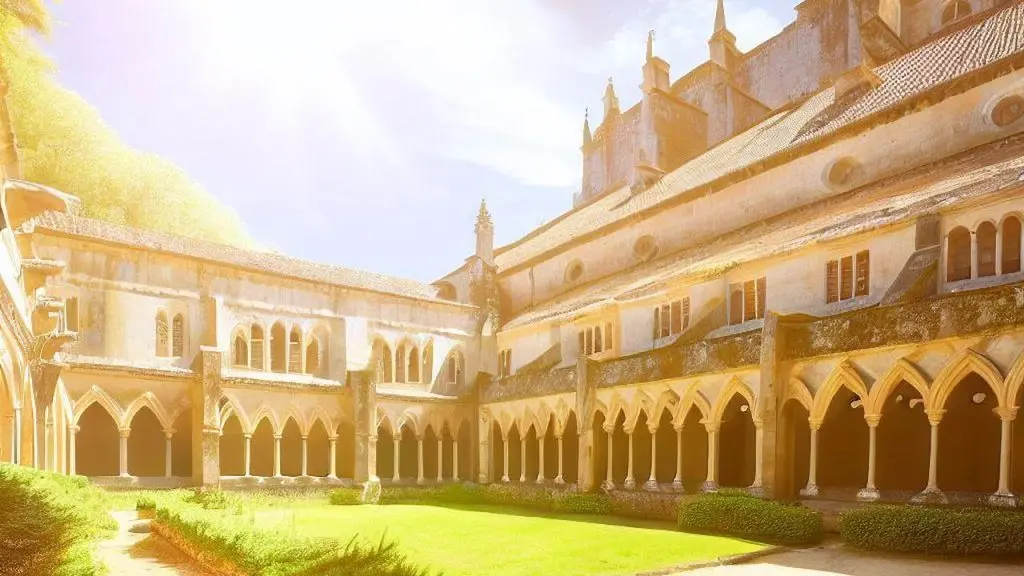
Sobrado Abbey Entrance Fees
As of my most recent information, the Monastery of Santa María in Sobrado dos Monxes did not charge an entrance fee for visitors to explore the main areas of the monastery. The site has been open to the public, welcoming pilgrims, tourists, and history enthusiasts to experience its cultural and spiritual heritage without requiring a fee for entry.
However, it’s important to note that circumstances may have changed since my last update, and it is always advisable to verify the current entrance policy before planning your visit. Entrance fees or voluntary donations might be introduced or adjusted to support the maintenance and conservation of the monastery.
To obtain the most accurate and up-to-date information regarding entrance fees or any special visiting guidelines, it is recommended to check the official website of the Monastery of Santa María or contact the site’s visitor center or tourist information office in Sobrado dos Monxes. These sources will provide the latest details on admission fees, guided tours, and any specific requirements for visitors.
Sobrado Abbey Visitor Facilities
As a popular tourist and pilgrimage destination, the Monastery of Santa María in Sobrado dos Monxes offers various visitor facilities to enhance the overall experience for those exploring the site. These facilities cater to the needs of travelers and provide amenities to make their visit comfortable and enjoyable. As of my most recent information, the following visitor facilities were available:
1. Information Center: The monastery typically has an information center or visitor reception area where tourists can obtain brochures, maps, and other informative materials about the site’s history, architecture, and visiting guidelines. The center may also provide details about any upcoming events or special exhibitions.
2. Guided Tours: Guided tours are often offered to visitors, allowing them to gain deeper insights into the history and significance of the monastery. Knowledgeable guides lead these tours, providing informative commentary and answering any questions that visitors may have. Guided tours are an excellent way to fully appreciate the cultural and architectural wonders of the site.
3. Restrooms: The monastery is likely to have restroom facilities available for visitors to use during their visit. Restrooms provide a necessary convenience for tourists, especially during extended tours or visits.
4. Gift Shop: Many historical sites, including the Monastery of Santa María, feature a gift shop where visitors can purchase souvenirs, books, postcards, and other memorabilia related to the monastery’s history and cultural heritage. The gift shop offers an opportunity for visitors to take a piece of the experience home with them.
5. Parking: Depending on the site’s location and accessibility, there may be designated parking areas for visitors arriving by car or tour buses. Adequate parking facilities ensure convenience and ease of access for those traveling by private vehicles.
6. Accessibility: Efforts are often made to ensure that the monastery is accessible to all visitors, including those with mobility challenges. Wheelchair ramps, accessible pathways, and facilities for visitors with disabilities may be available to provide a more inclusive experience.
7. Picnic Areas: Some historical sites, including the Monastery of Santa María, offer designated picnic areas or resting spots where visitors can relax, enjoy a packed lunch, or simply take in the tranquil surroundings.
It is important to note that the availability of specific visitor facilities may be subject to change or may have evolved since my last update. I recommend checking the official website or contacting the Monastery of Santa María directly to obtain the most up-to-date information about visitor facilities and any additional services or amenities that may have been introduced.
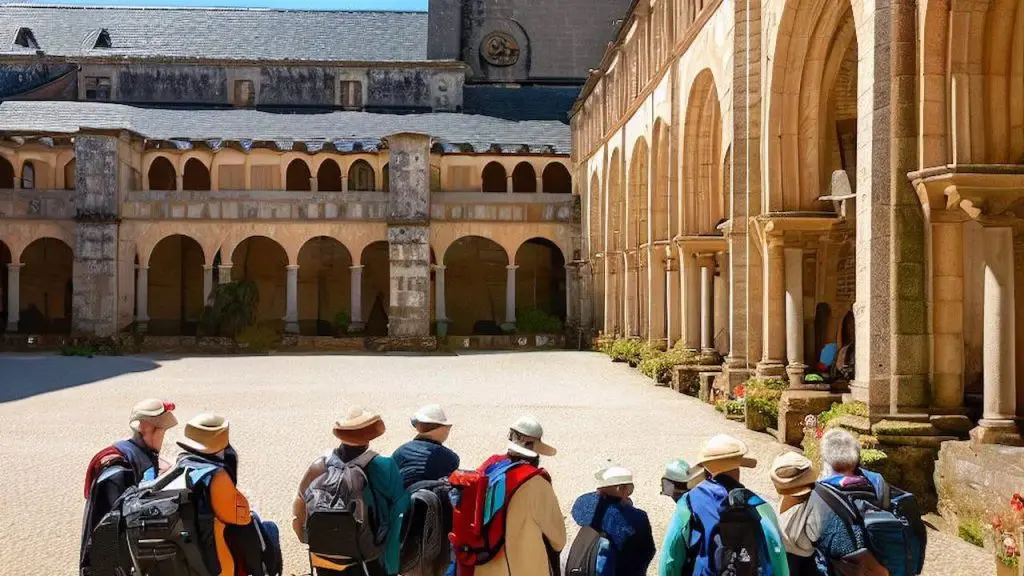
Sobrado Abbey as an Albergue or Pilgrim Refuge on the Camino Inglés
The Monastery of Santa María in Sobrado dos Monxes has long served as a sacred refuge for pilgrims embarking on the Camino Inglés, one of the lesser-known but spiritually enriching routes of the famous Camino de Santiago. Nestled amidst the serene landscapes of Galicia, Spain, this centuries-old monastery offers weary pilgrims not only a place of respite but also an opportunity to experience the timeless traditions of hospitality and devotion.
A Haven for Pilgrims:
The Camino Inglés, or the English Way, historically became a preferred route for pilgrims from the British Isles and other Northern European countries seeking to reach Santiago de Compostela, the ultimate destination of their spiritual journey. The Monastery of Santa María, strategically situated along this ancient path, opened its doors to offer pilgrims a place of shelter, sustenance, and spiritual guidance.
A Spiritual Oasis:
For centuries, pilgrims arriving at the Monastery of Santa María have found solace within its sacred walls. The tranquil ambiance and the reverence of the Cistercian monks create an atmosphere conducive to spiritual reflection and renewal. The monastery’s hallowed halls echo with the prayers of countless seekers who have come before, imparting a profound sense of unity with the past.
The Albergue Experience:
The monastery has a special role as an albergue, providing a traditional form of accommodation for pilgrims on the Camino Inglés. The albergue, or pilgrim hostel, offers a unique and communal experience. Pilgrims rest in shared dormitory-style rooms, fostering an environment of camaraderie and connection among travelers from diverse backgrounds.
Sharing the Camino Spirit:
The Cistercian monks who reside in the monastery are not only the guardians of its historical treasures but also the spiritual caretakers of the pilgrims who seek refuge within its walls. They extend a warm welcome to the pilgrims, offering them the traditional “Pilgrim’s Blessing” and guidance on the spiritual significance of their journey.
Camaraderie and Community:
At the albergue, pilgrims share meals, stories, and laughter, forming bonds that transcend language barriers and cultural differences. The communal dining experience, often with locally sourced and simple yet nourishing food, fosters a sense of shared humanity and the essence of the Camino spirit.
Experiencing Monastic Life:
Beyond the camaraderie with fellow pilgrims, the monastery’s albergue allows visitors to experience a taste of monastic life. Pilgrims may choose to participate in the daily rhythms of the monastery, attending morning and evening prayers or even engaging in contemplative practices within the peaceful cloisters.
Preserving Traditions:
The Monastery of Santa María, with its role as an albergue, plays a vital part in preserving the ancient traditions of the Camino Inglés. It upholds the spirit of hospitality and solidarity that has characterized the Camino for centuries, ensuring that the pilgrim experience remains authentic and deeply enriching.
As the sun sets on yet another day along the Camino Inglés, pilgrims at the Monastery of Santa María find solace in the knowledge that they are walking in the footsteps of countless seekers who have found renewal and purpose on this timeless pilgrimage route. The monastery’s role as an albergue continues to be a beacon of hope and sanctuary, welcoming modern-day pilgrims to experience the profound sense of connection and spirituality that has drawn travelers to this sacred path for generations.
Frequently Asked Questions (FAQs)
Here are some of the most frequently asked questions about the Monastery of Santa María in Sobrado dos Monxes
Is the Monastery of Santa María a UNESCO World Heritage Site?
The Monastery of Santa María in Sobrado dos Monxes does not have it’s own entry in the UNESCO World Heritage list for Spain, even though it is commonly thought of as being so, however it is an important part of the Camino Ways, which are listed
What is the historical origin of the monastery?
The monastery was founded in the 10th century by Cistercian monks and underwent various phases of expansion and reconstruction over the centuries.
How has the architecture evolved over time?
The original Romanesque structure served as the foundation, followed by Gothic, Renaissance, and Baroque elements, resulting in a unique architectural mosaic.
What is the spiritual significance of the monastery?
The Monastery of Santa María served as a center of prayer, study, and community life for monks and locals. It has also been a revered place of pilgrimage and spiritual retreat.
How has the monastery influenced Galician culture?
The monastery’s extensive library and archives have preserved the region’s language, customs, and historical records, influencing Galician art, music, and literature.
Are there any legends or folklore associated with the monastery?
Yes, the monastery is associated with various legends, including tales of a White Lady ghost, hidden treasure, and miraculous events.
Are there any visitor facilities at the monastery?
Yes, the monastery typically provides visitor facilities, such as an information center, guided tours, restrooms, and a gift shop.
Is there an entrance fee to visit the monastery?
As of the last update in September 2021, there was no entrance fee for visitors to explore the main areas of the monastery. However, it is advisable to verify the current entrance policy before visiting.
How can I travel to the Monastery of Santa María by public transportation?
The monastery is well-connected to nearby towns and cities by bus and train, offering convenient options for visitors relying on public transportation.
What conservation efforts are in place to preserve the monastery?
Ongoing conservation projects, public and private partnerships, and community involvement aim to protect and safeguard the monastery’s historical and architectural treasures.
What can visitors expect during their experience at the Monastery of Santa María?
Visitors can expect to immerse themselves in centuries of history, cultural heritage, and spirituality through guided tours, art exhibitions, and a serene ambiance.
Are there facilities for visitors with disabilities?
Efforts are often made to ensure accessibility for all visitors, including wheelchair ramps and accessible pathways.
How can I stay updated on the latest information about the monastery?
For the most up-to-date information on visiting the Monastery of Santa María, visitors can check the official website or contact the site’s visitor center or tourist information office.
Is the Monastery also a Pilgrim’s Albergue or Refuge?
Yes, the Monastery of Santa María in Sobrado dos Monxes serves as a Pilgrim’s Albergue (pilgrim hostel) along the Camino Inglés, a historic pilgrimage route leading to Santiago de Compostela in Spain. As an albergue, the monastery offers accommodation and hospitality to pilgrims who are walking the Camino Inglés.
A Timeless Monument
The Monastery of Santa María in Sobrado dos Monxes stands as a timeless testament to the rich cultural, historical, and spiritual heritage of the Galicia region in Spain. With its origins dating back to the 10th century, the monastery’s journey through time reflects the remarkable architectural evolution from Romanesque to Gothic, Renaissance, and Baroque styles, creating an awe-inspiring tapestry of artistic brilliance.
For visitors, the Monastery offers an enchanting journey through history. Guided tours, exhibitions, and cultural events provide immersive experiences, inviting travelers to connect with the past and appreciate the enduring legacy of this architectural gem.
As travelers explore the monastery’s intricate stone carvings, graceful arches, and sacred spaces, they are transported to a bygone era, evoking a profound sense of reverence and wonder. The legends and folklore surrounding the site add an element of mystique, captivating the imagination and adding to its allure.
